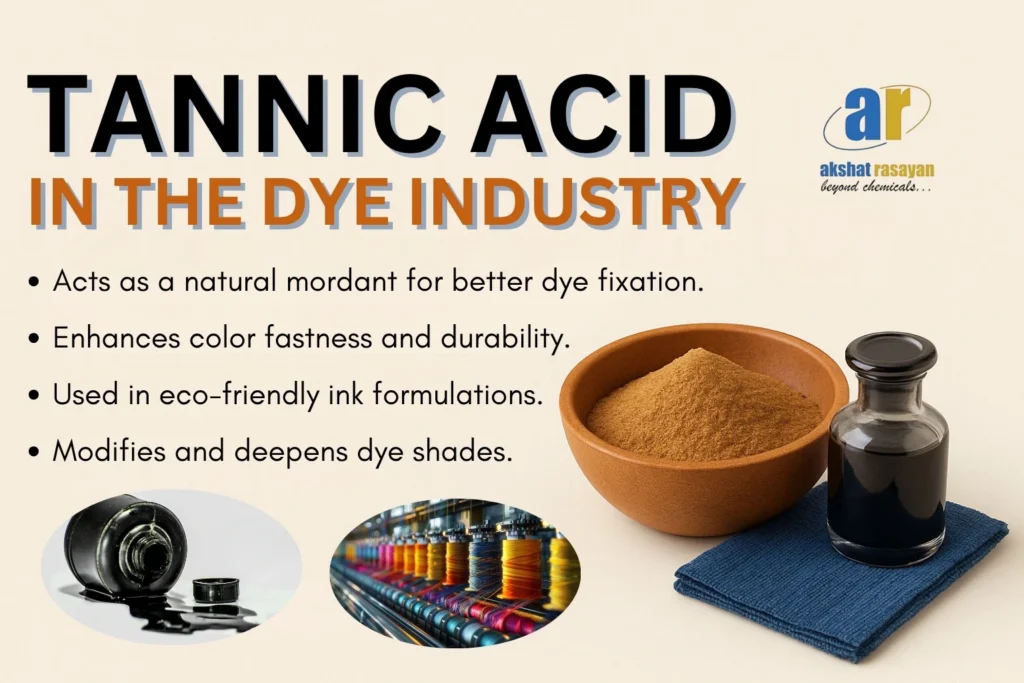At Akshat Rasayan, we take pride in supplying high-quality Tannic Acid to various industries—including ink and dye manufacturing. Derived from plant sources, tannic acid is a naturally occurring polyphenol with excellent binding, chelating, and color-enhancing properties. Its unique chemical profile makes it an indispensable compound in both modern and traditional dyeing and ink production processes. Let’s explore how tannic acid in the dye industry plays a key role.

Tannic Acid for Textile Dyeing
In the textile industry, tannic acid is widely used as a mordant—a substance that helps fix dyes onto fabrics. Particularly in natural dyeing processes, it enhances color fastness and vibrancy, making it a sustainable alternative to synthetic chemicals.
Benefits of Tannic Acid in Textile Dyeing:
- Acts as a natural mordant for cotton, wool, and silk.
- Enhances the depth and durability of colors.
- Reduces the need for toxic chemical fixatives.
- Environmentally friendly and biodegradable.
As consumer demand grows for eco-friendly textiles, manufacturers are increasingly adopting tannic acid-based dyeing solutions to meet both sustainability standards and performance expectations.
Tannic Acid in Iron Gall Ink: Time-Tested and Trusted
Iron gall ink is a historic ink formula used by ancient scribes and artists for centuries—and tannic acid was a central ingredient. When mixed with iron salts, tannic acid reacts to produce a deep blue-black pigment that adheres strongly to parchment and paper.
Why Tannic Acid is Used in Iron Gall Ink:
- Produces rich, permanent black color.
- Excellent resistance to fading and moisture.
- Easy to formulate and store for long-term use.
Even today, iron gall ink formulations are used in archival applications, calligraphy, and conservation work, and tannic acid remains a critical raw material in its preparation.
Use of Tannic Acid in Traditional Ink Manufacturing
In traditional ink production, especially in Asian and Middle Eastern cultures, tannic acid has been utilized for centuries. It was extracted from galls, oak bark, or nut husks and combined with other natural ingredients to produce long-lasting inks for manuscripts and documentation.
Applications in Traditional Ink:
- Herbal ink formulations.
- Handmade artistic inks.
- Religious script documentation.
By offering tannic acid of consistent quality and controlled purity, Akshat Rasayan supports not only modern manufacturing but also artisans and historians who keep ancient practices alive.
Why Ink and Dye Manufacturers Trust Akshat Rasayan
- High-purity Tannic Acid is available in bulk quantities.
- Sourced from reliable, natural raw materials.
- Compliant with industry standards for dye and ink applications.
- Efficient supply chain and competitive pricing.
With over a decade of experience in supplying industrial chemicals, Akshat Rasayan is a trusted partner for manufacturers in the textile, ink, and dye sectors.
Conclusion
The relevance of tannic acid in the dye industry continues to grow as the world leans towards greener and more sustainable manufacturing solutions. Whether you are producing textile dyes, iron gall ink, or traditional ink, tannic acid offers a versatile, eco-conscious option that delivers consistent performance.
Looking to source premium-grade Tannic Acid for your ink or dye production?
Contact Akshat Rasayan today to discuss bulk supply options and technical specifications.
